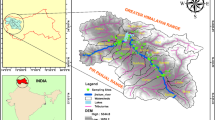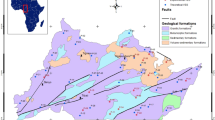Abstract
In the various geological formations of the research region, 57 samples from saturated sandstone strata were studied. The study’s findings revealed that the Kozeny–Carman equation offered estimates of hydraulic conductivity that ranged between 2.682 and 1356.28 m/day with an average of 256.04 m/day, whereas the Hazen model gave estimates that ranged from 0.08443 to 4.10745 m/day with an average of 1.552 m/day. Additionally, calculations using the Brayer empirical equation showed that hydraulic conductivity values ranged from 0.0247 to 2.388 m/day with an average of 0.576 m/day, but the Slitcher’s equations produced values that ranged from 0.129 to 14.999 m/day with an average of 2.82 m/day. Hydraulic conductivity readings from the USBR equation ranged from 0.00111 to 0.14287 m/day, with an average of 0.46 m/day. The improved ANN model produced hydraulic conductivity values that vary from 1.2764 to 6.9989 m/day with an average of 4.23158 m/day, contrary to the results of the prediction from the MLR approach, which showed values that ranged between 1.8631 and 6.9394 m/day with an average of 4.9655 m/day. It is clear that the MLR, ANN, and Slitcher models, in that sequence, may be used to predict hydraulic conductivity across the entire area because the estimates from the Slitcher, ANN, and MLR models are very similar to the pumping test data with RMSE of 5.140, 2.5754, and 1.0045, respectively.











Similar content being viewed by others
Data availability
The data will be provided on request.
References
Adegoke, O. S. (1969). Eocene stratigraphy of southern Nigeria. Collogue Sur Eocene, Vol. III Bur. Rech. Geol. Min. Mem No., 69, 23–48.
Alyamani, M. S., & Sen, Z. (1993). Determination of hydraulic conductivity from grain size distribution curves. Ground Water, 31, 551–555.
Amos-Uhegbu, C., Igboekwe, M. U., & Chukwu, G. U. (2013). Aquifer characterization and quality assessment of groundwater in Umuahia-South area of Abia state Southern Nigeria. Pacific Journal of Science and Technology, 14(2), 642–653.
Antolini, P. (1968). Eocene phosphate in the Dahomey Basin. Journal of Mining Geology, 17, 99–106.
Butler, R. P., Marcy, G. W., & Vogt, S. S. (1999). A transiting “51 Peg-like” planet. The Astrophysical Journal, 529(1), L41.
Carrier, W.D. 2003. Goodbye, Hazen; Hello, Kozeny-Carman. Journal of Geotechnical and Geoenvironmental Engineering.1054.
Cheng, C., & Chen, X. (2007). Evaluation of methods for determination of hydraulic properties in an aquifer–aquitard system hydrologically connected to a river. Hydrogeology Journal, 15, 669–678.
Choudhury, T. (2018)., Patidar, A. K., Mishra, A., Mishra, A., Agarwal, S., Pandey, A., Joshi, D Prediction of sonic log and correlation of lithology by comparing geophysical well log data using machine learning principles. GeoJournal, 1–22.
Cirpka, O. A., Tenkleve, S., & Nowak, W. (2003). Efficient computation of linearized cross-covariance and auto-covariance matrices of interdependent quantities. Mathematical Geology, 35, 53–66.
Dayhoff, J. E., & DeLeo, J. M. (2001). Artificial neural networks: opening the black box. Cancer Interdisciplinary International Journal of the American Cancer Society, 91(8), 1615–1635.
Ebong, E. D., Akpan, A. E., & Onwuegbuche, A. A. (2014). Estimation of geohydraulic parameters from fractured shales and sandstone aquifers of Abi (Nigeria) using electrical resistivity and hydrogeologic measurements. Journal of African Earth Sciences, 96, 99–109.
Ejiogu B. C., Opara A. I., Nwosu E. I, Nwofor O. K. Onyema J. C.. Chinaka J. C . (2019) Estimates of aquifer geo-hydraulic and vulnerability characteristics of the Imo State and environs, Southeastern Nigeria, using electrical conductivity data. Environ Monit Assess
Ekwe, A. C., & Opara, A. I. (2012). Aquifer transmissivity from surface geo-electrical data: a case study of Owerri and environs, Southeastern Nigeria. Journal Geological Society of India., 80, 123–129.
Ekwe, A. C., Opara, A. I., Okeugo, C. G., et al. (2020). Determination of aquifer parametersfrom geo-sounding data in parts of Afikpo Sub-basin. Southeastern Nigeria. Arabian Journal of Geosciences, 13, 189. https://doi.org/10.1007//s12517-020-5137-y.
Emberga, T. T., Omenikolo, A. I., Opara, A. I., Onyekuru, S. O., & Agoha, C. C. (2021). Comparative assessment of analytical models used for geo-hydraulic estimation in Imo River Basin, Nigeria. Online Journal of Earth Sciences, 15, 1–16.
Fatoba, J. O., Oloruntola, M. O., Mosuro, G. O., Laniyan, T. A., Ariyo, S. O., & Bayewu, O. O. (2014). Geophysical evaluation of groundwater potential in part of southwestern basement complex terrain of Nigeria. Applied Water Science, 7, 4615–4632.
Freeze, J. & Cherry, J.A. (1979). Groundwater. Prentice-Hall Inc., Engle Wood Cliffs, New Jersey. Pp 491. Herbert. R. and R. Kitchinq, R. (1981). Determination of Aquifer Parameters from Large- Diameter Dug Well Pumping. Groundwater, 19 (6).
Heigold, P. C., Gilkeson, R. H., Cartwright, K., & Reed, P. C. (1979). Aquifer transmissivity from surficial electrical methods. Groundwater, 17(4), 338–345.
Kozeny, J. 1927. Uber Kapillare Leitung Des Wassers in Boden. Sitzungsber Akad.Wiss.Wien Math.Naturwiss.Kl., Abt.2a, 136,271–306 (In German).
Molz, FL., Young, SC., (1989). Development and application of borehole flowmeters for environmental assessment. The Log Analyst 34 (01).
Ngwoke, M. O. (2013). Determination of aquifer parameters in Ishiagu Ebonyi state using geoelectric method. Unpublished M.Sc Thesis, Nsukka: University of Nigeria.
Nwankwor, G. I., Cherry, J. A., & Gillham, R. W. (1984). A comparative study of specific yield determinations for a shallow sand aquifer. Groundwater, 22(6), 764–772.
Odong, J. (2007). Evaluation of empirical formulae for determination of hydraulic conductivity based on grain-size analysis. Journal of American Science, 3(3), 54–60.
Opara, A. I., Ekeh, D. R., Onu, N. N., Ekwe, A. C., Akaolisa, C. Z., Okoli, A. E., & Inyang, G. E. (2020). Geo-hydraulic evaluation of aquifers of the upper imo river basin Southeastern Nigeria using Dar-Zarrouk parameters. International Journal of Energy and Water Resources. https://doi.org/10.1007/s42108-020-00099-3w
Oyeyemi, K. D., Adagunodo, T. A., Akinloye, M. K., Sunmonu, L. A., Aizebeokhai, A. P., & Abodunrin, F. O. (2018). Groundwater exploration in Aaba residential area of Akure. Nigeria. Frontiers in Earth Science, 6, 66.
Pinder, G. F., & Celia, M. A. (2006). Subsurface Hydrology. John Wiley & Sons Inc.
Rehfeldt, K. R., Boggs, J. M., & Gelhar, L. W. (1992). Field study of dispersion in a heterogeneous aquifer: 3. Geostatistical analysis of hydraulic conductivity. Water Resources Research, 28(12), 3309–3324.
Singha, S., Pasupuleti, S., Singha, S. S., Singh, R., & Kumar, S. (2021). Prediction of groundwater quality using efficient machine learning technique. Chemosphere, 276, 130265.
Sinha, R., Israil, M., & Singhal, D. C. (2009). A hydrogeological model of the relationship between geoelectric and hydraulic parameters of anisotropic aquifers. Hydrogeology Journal, 17, 495–503.
Ugada, U., Ibe, K.K., Akaolisa, C.Z. Opara, A.I. (2013). Hydrogeophysical evaluation of aquifer hydraulic characteristics using surface geophysical data: a case study of Umuahia and environs, Southeastern Nigeria.
Uma, K. O., Egboka, B. C. E., & Onuoha, K. M. (1989). New statistical grain-size method for evaluating the hydraulic conductivity of sandy aquifers. Journal of Hydrology, 108, 343–366.
Uma, K. O. (1989). An appraisal of the Groundwater Resources of the Imo River Basin: Nigerian. Journal of Mining and Geology, 25(1 & 2), 305–315.
Urom, O. O., Opara, A. I., Usen, O. S., Akiang, F. B., Isreal, H. O., Ibezim, J. O., & Akakuru, O. C. (2021). Electro-geohydraulic estimation of shallow aquifers of Owerri and environs Southeastern Nigeria using multiple empirical resistivity equations. International Journal of Energy and Water Resources. https://doi.org/10.1007/s42108-021-00122-B
Vukovic, M., & Soro, A. (1992). Determination of Hydraulic Conductivity of Porous Media from Grain- Size Composition. Water Resources Publications.
Whiteman, A. (1982). Nigeria: Its petroleum geology, resources and potential. I and II. London: Graham and Trotman Ltd. https://doi.org/10.1007/978-94-009-7361-9.
Acknowledgements
The Management of Tertiary Education Trust Fund (TETFUND), which sponsored this study at 100% through the 2020 National Research Fund grant cycle, is acknowledged by the authors for its support. We are grateful for the management and staff at the Anambra-Imo River Basin Development Authority in Owerri's technical and data help.
Author information
Authors and Affiliations
Corresponding author
Ethics declarations
Conflict of interest
All authors contributed to the idea, the design, the analysis and interpretation of the data, the writing of the article or its critical revision for significant intellectual content, and the approval of the final draft. This paper has not been sent to another journal or other publishing outlet, and neither is it being reviewed there. The authors are not connected to any companies that have a direct or indirect financial stake in the topics covered in the article. The following authors are connected to businesses that have a direct or indirect financial stake in the topics covered in the article.
Rights and permissions
Springer Nature or its licensor (e.g. a society or other partner) holds exclusive rights to this article under a publishing agreement with the author(s) or other rightsholder(s); author self-archiving of the accepted manuscript version of this article is solely governed by the terms of such publishing agreement and applicable law.
About this article
Cite this article
Emberga, T.T., Opara, A.I., Onyekuru, S.O. et al. Estimates of aquifer hydraulic conductivity based on grain-size data and multiple regression techniques in Imo River Basin. Int J Energ Water Res (2023). https://doi.org/10.1007/s42108-023-00244-1
Received:
Accepted:
Published:
DOI: https://doi.org/10.1007/s42108-023-00244-1




